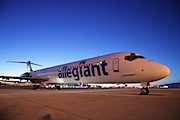
This week’s issue of PlaneBusiness Banter is now posted.
It was a busy week for the Things With Wings last week.
First, American Airlines reported its second quarter earnings results. The airline lost a lot of money. $390 million to be exact. $319 million excluding special items. However, you’d never have known it if you listened to the airline’s earnings call — which seemed focused on one thing — liquidity. Oh, and capacity reductions. That’s fine, but there are other aspects of an airline’s operations I’d like to hear about.
Then we had the blockbuster news concerning Continental’s Chairman and CEO, Larry Kellner. As I write in this week’s PBB, even though the management backbench strength at Continental Airlines is strong, and the airline should be able to carry on just fine as Larry goes to seek his fortune in the equity investment game — it’s quite discouraging to see one of the industry’s best and brightest leave.
Following up on our piece in last week’s issue about United’s bone-headed (or would that be heavy-handed) attempts to get travel agencies to take on more financial risk — or rather some travel agencies — the airline said late last week that it is going to give agencies 60 days to implement the business operation changes it seeks.
This whole thing still reeks. Nothing the airline says rings true.
Southwest Airlines had its own place in the spotlight last week, or would that be the sunlight, as the airline had a 737-300 aircraft develop a hole in the roof while enroute from Nashville to BWI. Not what the airline wants or needs — especially considering the issues the airline has had with the FAA concerning fuselage checks in the past. Preliminary NTSB report says there was no evidence of previous corrosion at the site.
That was not the only bad news Southwest had last week. The airline was also notified that its debt rating with Moody’s is under review, signaling a potential downgrade.
The Senate produced its version of an FAA Reauthorization bill last week. How did it differ from the House version? It differed on quite a few items. We talk more about that in this week’s issue.
Those misguided folks at the US Airways Pilot Association, the pilot union that was created in an attempt to circumvent the original ALPA seniority award that was handed down after US Airways and America West combined forces — had their head handed to them on a plate by U.S. District Judge Neil Wake last week. Wake issued his final injunctive order on the case brought against USAPA by the former America West pilots. Yes, we talk about this too.
Oh, and speaking of USAPA, we also give them, and our readers, a handy step-by-step instruction of how you correctly determine just how much an airline executive makes, using SEC documentation. Apparently the folks at USAPA have a problem figuring these things out.
British Airways raids its guaranteed employee pension benefit larder, Air Canada gets all of its employees “on board” with its 21-month contract extension program, and 215 Delta pilots sign up for the airline’s sweetened “early-out” package. Somehow I think the guys in suits over in Atlanta had hoped that number had been higher.
All this and more in this week’s issue of PlaneBusiness Banter.
If you are a subscriber, you can access this week’s issue here. If not, you can learn how you can become a subscriber by clicking here.







